Today, let’s delve into the differences between two somewhat similar embroidery threads. In the States, these two threads are called “coton a broder” and “floche.” Elsewhere, they may be called “broder special” and perhaps “floche a broder” or “coton floche a broder.”
In any case, there is confusion between the types of threads, from country to country, because they’re called different things. So I’m going to refer to the threads as I know them and explain their properties here, so that you can tell the difference between them and perhaps find them in your own country. You can at least know what I’m talking about when I use the names of the threads.
The ultimate point I want to make here is that coton a broder and floche are two distinctly different threads. Let’s look at them.
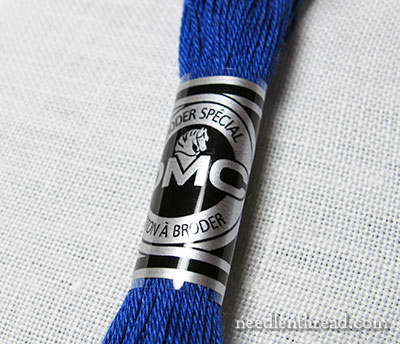
Coton a Broder
We’ll start with a skein of coton a broder, or broder special.
Properties: cotton; non-divisible (you use the thread just as it comes off the skein; it can not be broken down into smaller usable threads); 4-ply (that is, each strand is made up of four smaller plies of thread twisted together to make the one usable strand); mercerized (has a sheen); comes in various sizes or thicknesses and these are delineated by a number assigned to the thread size; only some sizes come in colors beyond white and ecru; it is also called “cutwork thread” or “whitework thread” because it is used (usually in white or ecru) in cutwork and whitework.
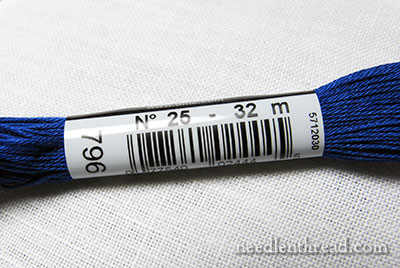
Size 25, shown here, comes in some 180+ colors in the States. The thread is not carried by DMC USA per se (you won’t find it listed in the products on their website), but retailers can buy it through certain DMC distributors.
Size 25 is normally coded as product 107 (or Art. 107) in DMC catalogs, color cards, and so forth.
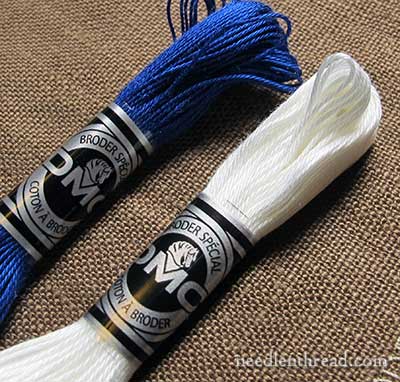
Above, size 25 (in blue) is lined up next to size 16 in white.
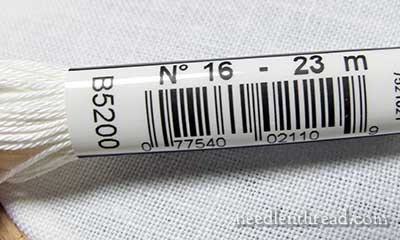
The size number is indicated on the longer label.
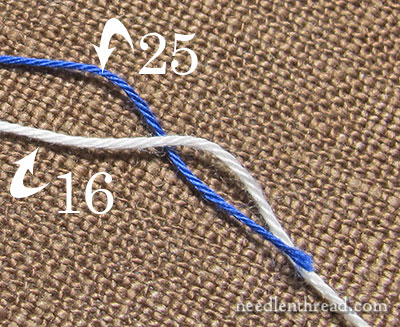
Size 16 is significantly heavier or thicker than size 25.
So, when it comes to sizes within the same line of thread, the lower the number, the thicker the thread.
Cotton Floche
Now let’s add some floche into the mix.
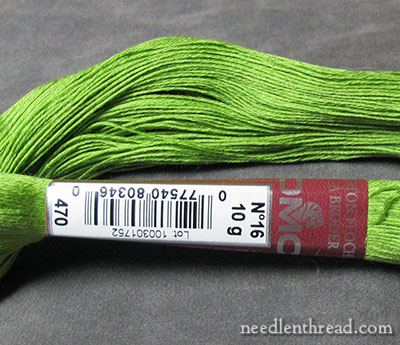
Properties: cotton; non-divisible (just like coton a broder, as explained above); 5-ply; mercerized; comes in one thickness, which is assigned a number, but which does not correspond with the same number in other lines of thread.
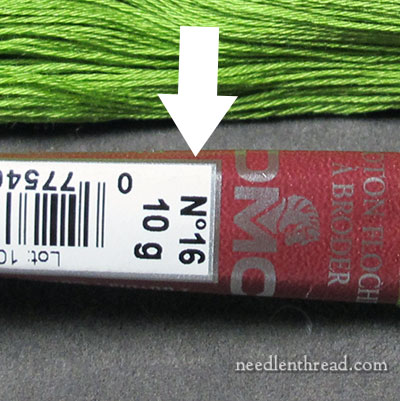
On the label, floche is called “coton floche a broder” and it has a size number, which is 16. And this can cause confusion, so we’re going to clear that up below.
When coming directly from the distributor, floche comes in large 10 gram hanks. Some shops may break these down into smaller put-ups to sell.
Here in the States in DMC catalogs, color cards, and the like, Floche (or Floche a Broder) is usually given the product code 5238.
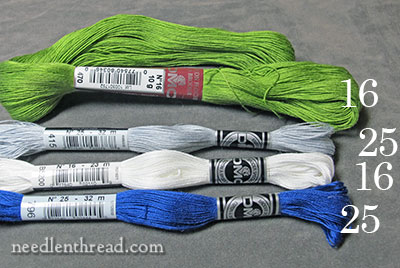
In the photo above, starting at the top, we have a hank of floche (the size number on the label is 16), followed by a silver coton a broder 25, a white coton a broder 16, and a blue coton a broder 25.
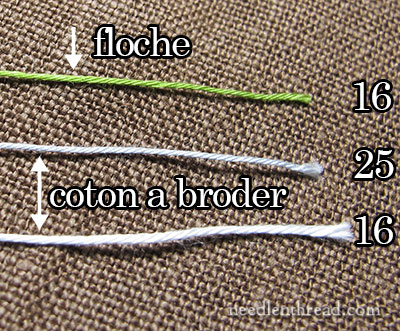
And here’s the rub:
The top green thread is floche, which has the size number 16 on the label.
The two lower threads are coton a broder. The middle thread is size 25. The lower one is size 16.
You can see that size 25 coton a broder corresponds more closely in size to floche.
You can see that size 16 coton a broder is quite heavy compared to the other two threads, and does not at all correspond to floche marked with size #16.
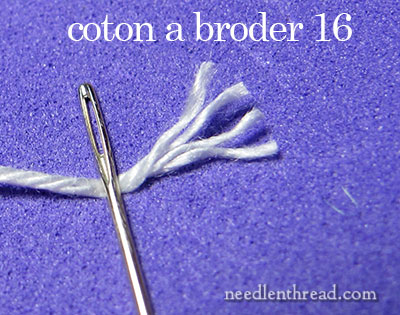
And now let’s look at their structure. Remember that both of these threads we’re talking about – coton a broder and floche – are non-divisible. You don’t take them apart to stitch with them. But we can separate the plies a little bit, to see how they are constructed.
Coton a broder 16 is made up of four plies twisted together to make one non-divisible thread.
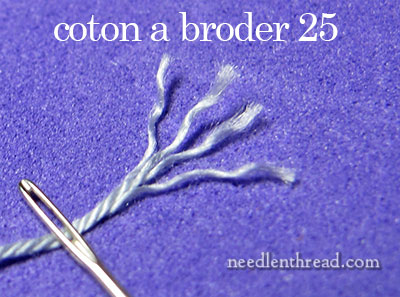
Coton a broder 25 is made up of four plies twisted together to make one non-divisible thread.
They are both the same construction, just different sizes.
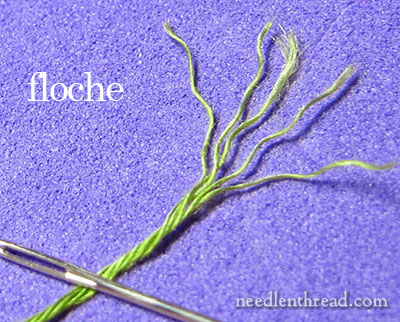
Floche is made up of five plies twisted together to make one non-divisible thread.
Floche is not as tightly twisted together as coton a broder, so it is a slightly softer thread when you stitch with it, and it has a bit more “spread” to it.
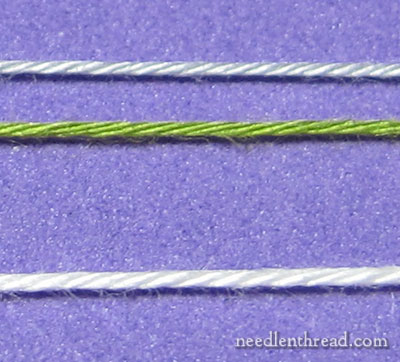
Here they are: coton a broder 25 on top, with the green floche right below it. You can see that the twists on the green floche look longer than the twists on the coton a broder, because the floche is not as tightly twisted.
At the base of the photo is coton a broder 16, which is significantly heavier than both of the threads above it.
Conclusion
If you are looking for a thread to substitute for floche because you can’t find floche, please don’t try to substitute coton a broder (broder special) in size 16. Instead, substitute coton a broder (or broder special) in size 25. The actual thickness of the threads will correspond better, and you’ll have a much better color selection.
We’ll look at some stitched comparisons later this week!
Questions? Comments? Suggestions? Have your say below!


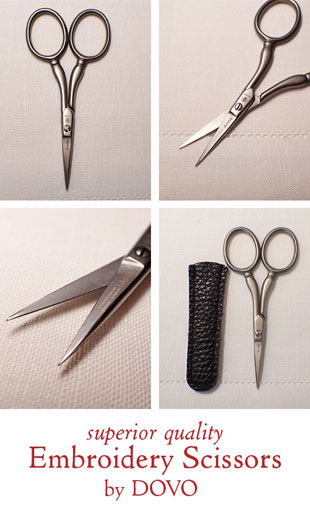

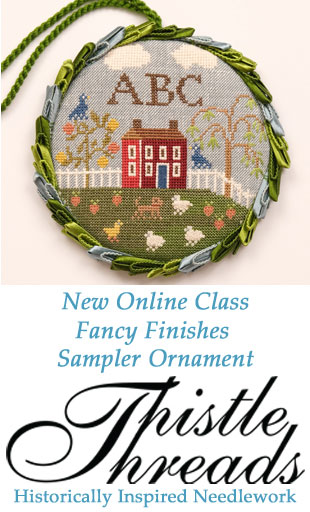
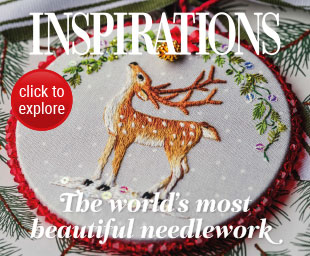

Would these threads be good to work alternating chain stitch with? And how much do they cost?
Sarah 🙂
They’re great for any surface embroidery stitches. You can find both threads at Hedgehog Handworks. Hedgehog is the only place I know of that puts the floche up in smaller twists, so they don’t cost as much, but you still get a good amount of thread with each twist. Coton a broder runs around $1.50 / skein, and the smaller put ups on floche from Hedgehog are around $1.30. ~MC
Very, very good explanation and just in time – I’ve read some very confused questions and answers about these threads this week. Thank you!
Having never used either of these threads I find this a most helpful tutorial! This is just the kind of post that keeps me coming back to your blog day after day. I have learned so much about threads I have never used which is very helpful when planning a new project. Thank you!
Thank you so much for providing education about embroidery threads. I had no idea that there are so many variables in threads but learning about them will help me make better choices in thread selection to enhance my embroidery. Keep the information coming, please! Thank you again.
Mary,
Thank you for trying to unconfuse me on these threads. I’ve read your article twice and will print it our for more study.
Thanks again,
Nelda
Mary, Thank you for this article. Would using different threads, Coton a Broder and Floche and/or DMC floss in the same design look right or just muddle the design?
Well, I think if you were judicious in your use of them, it could work. I may combine them on the hummingbirds, for example. We’ll see…. I think on the Lattice Jumble, I used most coton a broder 25, but I did use a little bit of floche for some of the non-lattice stitches, and it worked out ok. ~MC
Thank you Mary – another very informative and useful article!
You are simply one of the most didactic people I have ever observed, as well as extremely talented, but above all what I most like about you, is your generosity.
The World of Embroidery is much richer because of you. I am grateful that you are on this Planet.
Love to You,
Karin
Gosh, thanks, Karin! 🙂
Great explanation even for me (I don’t speak english…).
Thanks a lot.
Love this article. No one else (that I know) does this sort of comparison. I am very much enjoying your articles from the coloring book. Thanks for doing this!
Dear Mary
This is a great blog and really explains the difference between Floche vs Coton broder, they look very similar but when put together you can see there is a difference and I should imagine there’s a difference in texture as well. I do have some floche thread which I use sparingly because I can’t buy it in the UK. Thank you so much for explaining and defining the difference between the two thread and sharing with us your observations on these threads.
Regards Anita Simmance
I love to embroider with floche so watch for sources as I cannot buy it locally. Occasionally I have found floche on EBay.
At one time DMC must have been made floche in sizes other than No. 16 as I have skeins from No. 14 up to No. 8. The skeins are all obviously old. Most accompanied pieces of stamped linen for cutwork. I believe the linen dates to the 1930’s and 1940’s so assume the different sizes of floche do also.
Kim
Hi Mary,
Thank you, thank you, thank you. Best every explanation on these threads. I went back and looked at my thread. I did not have Coton a broder but Floche! Now I know why I was so confused about the size difference.
Barbara La Belle
Hi Mary,
I have the Lattice Sampler but have not started on it as yet. I have a local source for the Coton Floche with lots of lovely colors to choose from. Could I substitute the Floche for the Coton a Border to stitch this sampler?
Barbara La Belle
Finally a concise explanation on the two threads in one article. I will save this one and the others as they are available.
Thanks for a wonderful site. I do not do embroidery but find the subject fascinating.
Thank you for this great explanation. I always learn so much with my visits here. It seems as though there would be some standard for threads to be classed in….all #16 threads would be a certain gauge…especially when they are all from the same manufacturer.
THANK YOU! Coton a broder and floche are not available at my local stitching shops. Except for reading about them on the internet, I have no idea of what they are or how they differ from pearl cotton or stranded cotton. It is so good to learn more before spending money and waiting for mail order supplies without even knowing what you are getting yourself into! I can’t wait to see them stitched up. Can you show them next to pearl cotton and stranded cotton for those of us with limited pallets too. I’ve enjoyed seeing the difference in the stitching on the hummingbird project already.
This is so timely for me as I am gearing up to perfect monogramming and you have cleared up the difference! So for a linen guest towel primarily in satin stitch I want floche 16 or coton a broder 25?
Yes, I’d say so. You can use heavier coton a broder, too – 16 works for satin stitch, and 20 is a nice weight, too. But they don’t come in a wider array of colors, if you want to work with color instead of white or ecru. – MC
How do these threads compare to perle cotton?
I love stitching with it much more than floss.
Robin
Thank you. This has been very educational. I love getting this kind of information. Someday, I hope to try these threads on grander projects than embroidering my granddaughter’s clothing.
I remember years ago seeing a discussion of this on Compuserve. Borrr-r-r-ring! Nobody really had the whole picture. As Karin put it, you are a gift to the planet. It took energy to explain this! Thank you, Mary!
Thank you Mary, this has been a really helpful article today. I’ve been keeping an eye out for floche threads ever since you started mentioning them, but I’ve not been able to find a supplier in the UK. I thought I’d found one recently, but the thread described as ‘floche’ actually turned out to be DMC Coton Retors Mat No4 (also called Soft Embroidery Cotton here). Is floche thread only made for the American market, because I haven’t found a European supplier either?
It was very useful to see the comparison threads in close detail. I’ve been trying to weigh up whether to order floche from abroad or find a substitute thread locally. I can now see why the softer floche would spread very nicely when used for satin stitch, and it’s nice to know that Coton a broder 25 (which is available here) would be a very close substitute. Thanks Mary for the timely advice; I look forward to the stitch comparisons later on.
Hi Mary,
I apreciate your blog.
Here in Montreal (Quebec), Canada, I was told that DMC no longer produce Cotton floche and that what we buy is the remains of the stock the store still have.
I tried to have more info buy writing directly in French to DMC in France. They referred me to DMC of North America, but I got no answer to my inquiry.
Do you have more information about that situation?
Thank you so very much for this information.
The way you describe the different threads,along with the pictures,just makes it so clear.
You made my day,
Mary Alice
Hello!
This article is a prime example of why your blog is the best Mary. Your knowledge, expertise, personality, and generosity shine through.
Could you compare the regular dmc floss and perhaps others like perle cotton and crewel wool? It could be a whole series! Youve already started it with some good articles just need to link em.
Hope you have a good day!
Veronica
Yes, I’ll make further comparisons later in the week! Thanks, Veronica!
Thank you for the comparison between the two threads, and where they can be obtained.
My first question is: does the non-divisable coton a broder in size 25 compare to Perle Cottons, tatting cottons or crochet cottons in similar sizes?
Secondly, does the non-divisible coton a broder in size 25 equal one strand of DMC embroidery floss?
Hi, PJ – hmmm…to make the answers really short, I could say no and no! Or yes and no, and no. For your first question, they are much finer and softer than perle cottons, etc. although some higher numbered tatting and lace cottons, they would comparable to in size, but again, softer threads. To your second question, it is equal to approximately 2 strands – it’s slightly heavier than one strand. I’ll take the comparisons a little farther later in the week, so you can see how they line up. -MC
Thank you so much Mary this was so interesting and easy to understand .You really have a gift for explaining things . Now a problem Floche and coton a broder seem thin on the ground here in Queensland if any of your Australian followers know where to purchase same would be grateful. I do have a lot of regular DMC stranded embroidery thread but had not heard of the two above mentioned also have used perle DMC thread , once ah pagan thank you for your brilliant tutorials and sharing your projects.
Thank you Mary! What a great explanation. It’s hard to keep everything straight when there’s so much to know about thread comparisons. I have rarely met a thread I didn’t like–but–it never really registered that the construction & the twist made such a difference in embroidery performance until I started making lace. That was then & this is now, so I consult my “Threads for Lace” book before selecting threads. Also, I wanted to mention that I believe that Marion Scoular uses floche for blackwork in color & her results are far superior to floss.
Hi Mary-My but what a knot-ey thread tangle you are solving for us! You are doing a wonderful job too. I’m so excited about the new project. Just rec’d the Alabaster Angel fabric from Hedgehog and will prep it tonight. Thank you so much for all your works and talents!! xoxo Karen
Hi Mary, thanks for the informative post on a confusing subject! I was wondering how perle cotton fits in? They’ve got a lot of perle cotton (or coton perle as it says on the label) in Joann/Michael’s but I can’t find much info on it on the embroidery blogs I follow.
This is a very clear picture of the differences in the threads mentioned. Thank you, Mary, for your wonderful post.
Ah, that clears up some questions I’ve had. Thanks, Mary! I never fail to learn something useful from your posts.
I hope you’re all stocked up and ready to burrow in for a few days, another snow-mageddan is moving in. Or possibly just a little snow and a lot of hyperbole from excitable weather people. Either way, don’t you just love sitting in a snug house, peacefully stitching while the weather rages outside? It’s one of my most favorite things to do.
Hi, Robin – yes, it’s already started here. Only about an inch so far, but we’re expecting about twelve inches by the end of the day, which is a pretty good sized amount for Kansas. Definitely not going anywhere for the next day or so! 🙂 Love the snow, not so much the deep freeze following it! -MC
Outstanding. Decade or so ago we had to use #12 and #16 for Ukrainian embroidery based on traditional patterns for an EGA group correspondence course and I was delighted it came in colors beyond white and ecru. Then when experts kept talking about using Floche for better techniques of monogramming and whitework techniques, I sought that too. But there was real confusion about whether Floche was the #25 and your feature here will be my guide. Thanks ever so much for the detailed visual comparisons & info.
Hi Mary,
I have another type of “broder” floss called Retors a Broder by DMC. It’s labeled No. 4, 10 metres coton, made in France. I was given a large selection of colors – very bright and beautiful! It has 5 strands and does not seem to be divisible. It is non-mercerized so is very matte – with a very soft appearance. What type of needlework is this used for? I’ve never seen or heard of it before.
Thank you!! Katrina
Hi, Katrina – Retors 4 is used primarily for needlepoint. It’s a very thick thread – almost more of a “yarn” – but you can also use it for very chunky embroidery! – MC
Thankyou so much for giving out such wonderful informations from time to time, it shows your dedication to your work and how committed you are to teach others.There is so much to learn from you. I am so glad I have subscription to your site.
Ah, you’ve cleared up a mystery for me, thanks very much!
Wonderful article, Mary, and you did an excellent job of explaining the difference between the 2 threads. Some one asked about the price – the skeins of coton a broder are usually about $1.50 / skein and the skeins of floche are $6.30/skein. This may sound like floche is a bit more expensive, but in reality, the coton a broder#25 skeins have 32 meters and the floche skeins have 150m, so the floche is actually a bit less expensive, when you price it by the yard. One other thing, for you novice floche users! If you are opeing a skein of floche, keep in mind that it is wound like an old hank of yarn. If you startpulling on one thread, it will make a huge rat’snest and isnext to impossible to get undone. If you take off the label and look towards the top of the skein, you will see a little know in the floche – this is the end that is tied around the skein. Carefully clip the little knot and then take scissors and cut through the whole skein. This will give you a 54 inch length of floche. Unless I am using it for something that I need to have a long piece for, I then divide the floche into thirds and cut, giving me 3 – 18″ little hanks of floche. I make a soft knot in each little hank to keep them from falling apart. I put the color # on the outside of a ziploc bag with a Sharpie and then store the floche inside. Both of these threads are wonderful to work with!
Forgot to add – both the coton a broder #25 andthe floche are equal to about 1.5 skeins of regular stranded floss. When smocking, we udually use three strands of stranded floss, but 2 strands of either floche or CaB #25 are about the same as 3 strands of stranded floss.
A final thought and then off to bed……… floche is used for almost all of the embroidery on the island of Madeira. The first time we wnet to one the Imperial Bordados factory (sadly now closed), it was before floche was readily available in the U.S. On the first day when we went to upstairs in the factory for our classes, they opened a big antique armoire and it was full of all different colors of floche. They use if for their cutwork, padded satin stitches, bullions, granitos, etc.
Thank you for clearing my initial confusion. This post is absolutely brilliant!
Dear Mary, I must say a big thank you for the information about Coton a Brodor and Floche. Years ago my favourite store (now closed, sadly) had some Floche which I promptly bought to add to my stash. I have never used it. Now I am about to use some Coton a Brodor and was wandering if they could do the same job. So you can imagine your article was just what I needed. So many thanks, I love your website
Thanks so much Mary. So very informative and very understandable now.
Thanks for this really useful information. I didn’t realise that there was more than one choice of this type of thread – thank you!
Thank you, Mary. Excellent explanation.
Mary, I accidentally came across this supplier of floche in white only it seems in France. I have placed an order for a couple of skeins of 10g at Euro 4,80 per skein. I found your recommendation of this thread for monogramming and have desparately wanted to try a monogram after building myself an inspiration board of monograms on pinterest.
http://www.merceriedelavieilleville.com/produit/fils-a-broder/dmc-floche-a-broder
PS – I adore your newsletters – real proper embroidery.
Kind regards
Sue (London UK)
Dear Mary,
I can’t tell you how excited I’ve been about your posts recently. I have been wanting to ‘graduate’ from embroidering tea towels with a few simple stitches to something a little more serious, but I didn’t know precisely where to begin.
Sorry, didn’t mean to submit just yet.
Continued…
I planned to go to a fabric store for linen, when a few days later you admonished me not buy regular fabric, it’s too nubby and not suitable for embroidery. Then, I was wondering which threads to use, and I saw this post! I just need to stay a few steps behind you and I’ll have all my questions answered : )
I’m anxious to begin a more ‘serious’ project from your Church Embroidery book. Can’t wait!
Thank you for all you do.
Mary,
This was a great explanation of the two threads, I do not have access to the “coton a broder” fibers, they look lovely. I do however carry the full line of the Floche in my shop in Cincinnati. Can you give me a source for the coton for purchase for my shop??
I do see that it is a dmc product, however all of my dmc suppliers do not seem to carry it as yet…..
Thanks
Dawn
Hi
I live in England. When I Googled ‘cotton floche’ I was directed to a usually reliable needlework site. On this website, ‘cotton floche’ was interpreted as ‘crochet cotton’. The label is “DMC Natura Just Cotton’. Although it can be divided (into 7 very fine strands) it clearly is meant to be used as a whole thread. I don’t think it IS ‘floche’ at all. What is it?
And what should I be asking for over here?
Hopefully, paula, expatriate in England
Hi Mary,
Thanks for explaining the difference between coton a broder & Floche. Could you please tell me what the difference is between coton a broder & Baroque (dmc-usa) crochet cotton size 10 (Art 159)?
Hello Mary
Thank you for this series, I am finding it fascinating. My sister in law introduced me to your site, I’m very glad she did.
My question is, is the floche thread possibly what I know as flower thread here in the UK.
Warm regards
Julia O’Gara
Hi, Julia –
Flower thread here in the US (often sold as “Danish flower thread”) is a matte thread – there’s no sheen to it. Floche is mercerized, so it does have a sheen. There seems to be some confusion between the names of the threads, as I have seen that some teachers and authors from South Africa, from the UK, and from Australia call different threads different names. But if you go to the source of the threads – the original “Danish flower thread” originally dyed by Einar Hansen, for example – it was a matte thread, without a sheen. Floche, a product of France, is a mercerized thread with a sheen. Coton a broder (which is another thread whose name is sometimes confused with flower thread) is a mercerized thread in most countries, including the UK (it is used for whitework – you can check the RSN essential guide to whitework and they have it listed as such in there). So I think flower thread, if considered correctly, is a matte thread, whereas floche has a sheen to it. Hope that helps a little…though it all sounds rather confusing, doesn’t it?
Hi Mary,
Could you please tell me what the difference is between coton a broder & Baroque (dmc-usa) crochet cotton size 10 (Art 159)?
Well, the structure will be completely different. The crochet cotton will be more tightly twisted and probably made of fewer but heavier plies. But I’m not sure about the size difference, as I don’t have any crochet cotton on hand. – MC
Hola Mary, saludos desde México, me puedes indicar si hay toda la gama de colores en floche? y donde los consigo on line? Muchas gracias por tus atención y consejos
Hello, Guadalupe – Here is a copy of the color card: http://lacis.com/catalog/data/links/DM75%20DM76~Color%20Card.pdf You can buy floche through Hedgehog Handworks in the US, here: http://www.hedgehoghandworks.com/catalog/FBRFABT.php It is on sale right now, until March 1. ~MC
Can you please explain the difference between floche and flower thread? Thank you
Hi, Penelope – you’ll find it here: https://needlenthread.wpengine.com/2008/08/cotton-floche-vs-danish-flower-thread.html
This comes just at the right time for me as i’m gathering my supplies to make the crazy quilt “peacock” square from Pamela Kellog’s Kitty & Me blog site. I want to embroider the body of the bird in long and short stitch and even though she used rayon thread for the sheen it has, which I had intended to use,I’m going to try to use the floche. First because I think it will look more lifelike, and second, because I feel it will cover up any less than perfect stitching on my part.
I can’t tell you how much I appreciate the lessons/information you give us. Yours is the very first piece of mail I open when I log on each day. Not only are you a gifted artist, you’re also a wonderful teacher! Yours and His, Deonia in Florida
Where can I purchase DMC floche in smaller yardage than Hedgehog handworks website has?
Hi, Sarah – did you see the smaller put-ups that Hedgehog sells? They are thirty yard twists, rather than the 168 yard skeins. This is a link to them: http://www.hedgehoghandworks.com/catalog/FBRFABT.php Floche comes from the supplier in the large skeins or hanks (168 yards), and Hedgehog breaks them down and sells them at a fraction of the price. I haven’t found floche available elsewhere in all the colors available, in smaller put-ups.
Very clear explanations. I am using a netting pattern found in The young woman’s book: a useful manual for everyday life, an book published in 1877. The instructions call for both cotton, boar’s-head #60 and French embroidery cotton. Do you have any idea what would be a comparable thread.
Hi, Rita – You might look up Marie Suarez’s whitework embroidery – she is located in France. She has some specialty threads produced for whitework, some of which are the higher numbered cottons.
I have always used 6 strand embroidery floss, several years ago, at a quilt show, i purchased a redwork pattern and the vendor suggested that i try an alternate type of thread, it is equivalent to X number of embroidery floss, i purchased 1 spool and loved using it. i lost the spool and cannot remember the name of the thread, type of thread or any distinguishing criteria. i would love to purchase additional spools, and hopefully find the dark red to finish the remaining blocks for the second project that i started, could you help. i know that the local fabric shops (Joanne’s or Hancocks) in the small town that i live in do not carry the thread, i tried to order it from an internet source, but cannot find an embroidery thread that comes on a spool. cant remember vendor, pattern name is incomplete on my project.
thanks
Hi, Bobye – You’re probably looking for Cosmo’s multi-work thread. Just Google “Cosmo multi-work embroidery thread” and you’ll surely find some online resources that sell it. It’s two strands of floss that come off the spool together, and it comes in a somewhat limited palette of colors. It’s great for redwork and the like. Hope that helps!
Mary, your article of Feb. 2014 on selecting threads is, as always, totally informative.
I may be way off-base… a hair-pulling feeling… but have you entertained the thought of doing a simplified chart of all of your thread comparisons (perhaps a PDF file for a nominal fee) thus eliminating the scrolling up and down when following/reviewing your comparisions?
I ask this only because I do rely on your knowledge as I strive to learn “forever” the art of selecting threads.
Perhaps there is an easier way of charting your info that I could do myself, but haven’t thought of (or maybe a cut n paste method)!
Thanks for listening! Jo in SC
How do you store the 10g hanks of coton floche a broder? I know at one point you were using a hanging system that was stored in a file cabinet. I’ve received some Hanks and have more on the way so I need to find a system. I have two sets of Bisley drawers, file cabinet drawers, and a chest of drawers. But not living in the States, it sometimes takes a while to get things. Suggestions?
Hi, Barb – My hanks of floche are all tidily stored in my Bisley cabinets. They certainly take up more space than normal skeins of thread, but since I don’t go through them very quickly, it’s nice to have them laid out in drawers where I know they will be safe for a while!
Mary,
Are there specific projects where you choose one over the other?
This is my big problem…I’d like to try them all, but always womder what I should use for which type of project. …..And silk! When does one turn to silk?
Coton a Broder 25 is hard to find in my area. Can I substitute DMC floss. If yes how many strands.
Thanks
I’d substitute 2 strands of floss for Coton a Broder.
Your comments regarding cloche and coton de broder remind me of sashimi thread used in Japan and here for born/shashiko stitching. How does this thread compare with the two threads you mentioned in your newsletter (or blog?)? I have been using it for boro stitching and also for couching (the shashiko thread being held down by lighter weight thread—probably by split embroidery strands).
Thank you for your informative emailings,
Ginnie Mickelson
Floche and coton a broder differ from sashiko thread in that sashiko thread is not, to my knowledge, mercerized. I believe it is a matte thread without a sheen – like Danish flower thread. If it is mercerized, it’s still not got the same sheen as coton a broder and floche, so there is something definitely different in the manufacturing process. I don’t know if the structure is similar to coton a broder (it looks more similar to coton a broder than to floche) – I’d actually have to take the threads apart and compare them – but they are all three similar insofar as they are used straight off the skein and not meant to be separated into finer strands.
Thank you, all your information is clear and very helpful.
Hi Mary,
I have some skeins of floss that say “Mouline Special” on the top of the label, and “Coton a Broder” underneath. Some of my other Mouline just says “8” underneath. They both look identical, though- 6-stranded floss. Was Mouline changed sometime over the years in the US?
That’s the regular six-stranded floss. The “coton a broder” I’m talking about in this article is soft cotton, non-stranded, and it comes in different weights (although the #25 is the weight available in a wide range of colors).
I used to be a weaver and know that in an 8/2 or 8/4 yarn that the 8 was the weight of the yarn, and the /2 or/4 meant the number of strands twisted together, making up that weight. Now, I’ve taught myself to crochet, and have been using “size 4” yarn according label which uses the Standard Yarn Weight System from the Craft Yarn Council. According to their system, a 7 would be roving size, but I know the 8/2-8/4 that I’ve been looking at is quite smaller. How does that size 4 compare to the 8/2, 8/4, etc method of sizing? Is there a way to figure out what yarn on the 8/2 scale is comparable to a size 4 on the Crafter’s Yarn Weight System?
Thank you, Lisa
I’m afraid I’m not a weaver or a spinner, so I can’t really help you with the ins-and-outs. I can only compare it to weights of other embroidery threads. These are embroidery threads, by the way, not yarn (which is a completely different kettle of fish), so I suspect it’s like comparing apples to oranges in some regards.
Is there a difference in the sheen?
They’re both mercerized cotton, so they both have a sheen. Because of the softer twist on the floche, I think the sheen is more pronounced, although… mmmm… it really depends on the stitches you use, too.
Do you know how thick (in mm) the cotton broder no.16 is?
In millimeters? No. Soft thread isn’t generally measured in millimeters. If I were comparing it to something, I’d probably compare it to a #8 cotton pearl thread, but with a looser twist, so it actually covers better.
That’s perfect and super helpful. Thanks Mary!
What size embroidery needle is best for Floche?
I use a size 7 or 8
Wow. As always you are a mountain of information and I thank you.
I am trying to work out if Perle size 8 is comparable to Coton a Broder size 16 for some redwork I am planning as I have loads of Perle No 8 already.
Can you advise?
Thank you
Hi, Dawn – The perle #8 is heavier. It’s also more tightly twisted and fewer plies, so it makes for a “bumpier” thread over all. But, that said, it should still work for rework. You might try a little bit on your design and see if you like it. It’s always good to test the threads you’re thinking about, anyway, so maybe try a small portion of the design with the #8 and see if it works the way you want it to.
Thank you so much for your reply Mary, that’s really helped. Xx
Mary,
The United States DMC website shows a product called “Soft Cotton”. Is this the same as cotton a broder? The website does not give info about the size of the thread but, because it comes in many colors, could I assume it comes in size 25 if it indeed is cotton a broder?
Thanks, Josie S.
Matte cotton and soft cotton are thick tapestry yarns, used more for needlepoint than embroidery. Much heavier than Coton a Broder!
Hi Mary,
I was hoping to scratch your mind for what to do with my thread substitution problem.
I bought some Lugana 25-ct evenweave fabric a while back and was looking at Hardanger books and getting excited when I noticed that my Lugana (which I bought in the Wedgewood color) needed two different-sized threads, only one of which I could match to the fabric. I could easily find floss (two strands of which is used in lieu of the 80/3 linen) but I could not find the thicker size 12 perle cotton in the Lugana color, which would have substituted for the thicker 50/3 linen thread originally called for. Only size 8 perle was available.
Fast-forward to today and you’ll see I’ve been re-reading your thread comparisons, looking for solutions.
Would a size 8 perle cotton be thin enough to substitute for a perle size 12?
Or could I use 3-4 strands of the floss as a substitution for the size 12 I need?
(I doubt I’d even find the color Wedgewood in any floche or Coton a broder!)
Anyway,
Hope you’re enjoying your new digs!
Christine
Hi, Christine – Thanks for your note! I can’t answer your questions with accuracy right now, because I can’t access the threads you want compared. I can tell you that size 8 perle cotton is distinctly heavier than size 12.
Coton a broder #25 is available in about 180 colors, so you might find the color you need.
Maybe you should just test the techniques with the threads you have, to see which works best? Couldn’t hurt! 🙂
Thank you for posting this. I never noticed the No 16 or No 25 written on the tabs. I have some floss who’s labels are different. I will have to look to see if they are number on them.
I know it’s ten years later, but this information was very helpful. Thank you very much. 🙂
Glad to hear that, Penny!
I saw a glowing review for dmc floche and
i’d like to try it but no store carries it. It must be online somewhere, anyone know?
The chicken scratch looks interesting and very decorative. I’ve heard of it before but never tried it. I know gigham is available locally but I saw that the gigham has to have about 1/8th inch color blocks and the same number of blocks going up ansddown and side to side. Is this true?
Sue H.
h
Hi, Sue – I sell cotton floche here: https://shop.needlenthread.com/product/cotton-floche-color-collections
I sell it in smaller curated collections, with the hanks broken down, to make it more affordable to acquire many colors. Otherwise, each color ends up costing about $7.50 / hank.
I do gingham embroidery on 1/8″ check. It can be done on any gingham. I lot of the “traditional” chicken scratch in the US was worked on homespun, which generally has a slightly elongated check (slightly more rectangular than the woven gingham check that you’ll find in high quality cottons). The fabric is also a bit rougher. And the check is just around 1/4″. With this type of chicken scratch on that size scale, you’ll have to “size up” in your thread weight – you’d use a heavier thread to work the embroidery.